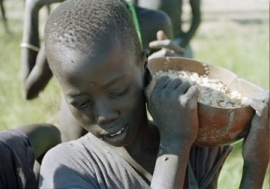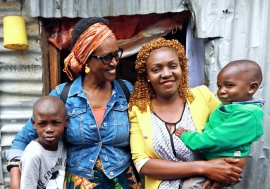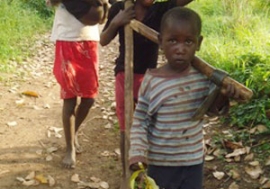Global AIDS treatment drive takes off
Global AIDS treatment drive takes off
When a reporter first met seven-year-old Bongani in a hardscrabble shantytown near Johannesburg in 2003, it was evident the child was dying. He was too weak for school, stunted and racked by diarrhoea. There was little question that he, like his deceased parents, was infected with the human immunodeficiency virus that causes AIDS. It seemed equally certain that he would soon lie in a tiny grave next to theirs -- joining the 370,000 South Africans who died from the disease that year.
But when the journalist, Mr. Martin Plaut of the BBC, returned a year later, he found a healthy, laughing Bongani poring over his lesson book. “The transformation,” Mr. Plaut wrote last December, “was remarkable.”
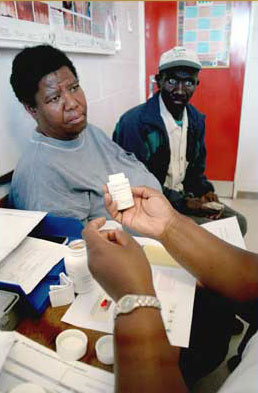 A couple receives ARV medications in Cape Town, South Africa.
A couple receives ARV medications in Cape Town, South Africa.That transformation -- and the difference between life and death for Bongani and a growing number of people living with HIV and AIDS in Africa -- has resulted from access to anti-retroviral drugs (ARVs) that attack the virus and can dramatically reduce AIDS deaths. For years high costs severely limited their use in Africa. The Joint UN Programme on HIV/AIDS (UNAIDS) estimated that only about 50,000 of the 4 million Africans in urgent need of the drugs were able to obtain them in 2002. But with prices dropping in the face of demands for treatment access and competition from generic copies of the patented medications, the politics and economics of AIDS treatment have finally begun to shift.
In December 2003, the World Health Organization (WHO) announced an unprecedented drive to put 3 million people living with HIV/AIDS in developing countries on ARV treatment by the end of 2005, the “3x5” campaign. Two months later, the US launched an ambitious programme of its own, the President’s Emergency Plan for AIDS Relief (PEPFAR) -- a 5-year, $15 bn initiative to provide ARV therapy to 2 million people and prevent 7 million new infections by 2008 in 15 countries, including 12 in Africa.
‘Irresponsible’ goal now in sight
The early results are encouraging. In January 2005, WHO, joined by representatives of the US government, UNAIDS and the multilateral Global Fund to Fight AIDS, Tuberculosis and Malaria, announced that the number of people receiving ARV treatment in developing countries had increased by 75 per cent during 2004 to over 700,000 -- including an estimated 325,000 in sub-Saharan Africa. In the view of many public health experts, the rapid increase vindicates what some critics derided as WHO’s “irresponsible” and unrealistic 3x5 pledge.
The results also seem to belie predictions that the mix of multilateral and bilateral funding and treatment programmes would prove impossible to coordinate and only further burden overstretched health systems in the worst-affected countries. South Africa, Nigeria and India account for over 40 per cent of the total number of people still in need of ARV treatment, and experts say that a focus in those three countries could produce major gains for treatment access in a short time.
Speaking at a press conference at the World Economic Forum in Davos on 26 January, WHO Director-General Dr. Lee Jong-wook singled out developing countries for much of the credit. “We salute the countries that have now shown us that treatment is possible and can be scaled up even in the poorest settings,” he said. “AIDS treatment access is expanding every day thanks to the dedicated work of doctors, nurses, health workers and people living with HIV and AIDS, who are often working under difficult circumstances to turn the dream of universal treatment into a reality.” WHO officials assert that at current rates the world is on track to reach the 3x5 goal.
|
ARV treatment access in countries most affected
|
|||||
| Country | Adults with HIV 1 |
Adult infection rate |
Number needing treatment 2 |
Number getting treatment 3 |
% under treatment |
| Swaziland |
190,000
|
38.8
|
36,500
|
5,750
|
16
|
| Botswana |
330,000
|
37.3
|
75,000
|
37,500
|
50
|
| Lesotho |
300,000
|
28.9
|
56,000
|
2,750
|
5 |
| Zimbabwe |
1,600,000
|
24.6
|
295,000
|
8,250
|
3
|
| South Africa |
5,100,000
|
21.5
|
837,000
|
55,000
|
7
|
| Namibia |
200,000
|
21.3
|
32,000
|
92,50
|
28
|
|
1 End 2003.
|
|||||
This upbeat assessment is tempered, however, by an estimated $2 bn shortfall to reach the 3 million mark by the end of this year. That amount is part of the $6 bn in additional resources UNAIDS says is needed in 2005 for the full range of HIV/AIDS programmes in developing regions. The treatment drive in many countries is hampered by severe shortages of trained medical personnel and facilities and by continuing controversies over drug prices and patents. “Unless these and other pressing issues are addressed urgently,” declared the non-governmental organization Médecins sans Frontières (MSF), “many of those living with HIV/AIDS in developing countries will never get access to life-saving treatment or may not be able to survive once on treatment over the long term.”
MSF and other advocacy groups point out that the 700,000 people in ARV treatment represent only about 12 per cent of the nearly 6 million people in developing countries who need it. With the disease taking 8,000 lives daily, and new infections topping 5 million last year alone, MSF declared that “the global picture is bleak.... WHO ... and other institutions should be sounding the alarm.”
‘A tremendous determination’
Whether one views the pill bottle as half empty or half full, the increased availability of anti-AIDS medicines in Africa is very good news. Although the percentage of Africans currently receiving the life-prolonging drugs remains a low 8 per cent of those requiring it -- ARVs are prescribed only for those in the final stages of the disease -- the continental average masks significant advances in some countries.
In Botswana, the country with the second-highest HIV-infection rate in the world, an estimated 50 per cent of those in need currently receive ARV drugs. This is due in large part to the government’s pioneering decision in 2002 to provide the medications free of charge through the public health system.
Uganda, whose AIDS prevention campaign is already considered a model for effective programmes, now provides ARV treatment to 40 per cent of the 114,000 people who require it. In Cameroon, reports WHO, strong political leadership combined with increased funding assistance and a sharp drop in drug prices has allowed some 12,000 people to begin ARV therapy. Cameroonian authorities say they will triple that number by the end of 2005.
Overall, notes WHO in its December 2004 3x5 Campaign Report, anti-retroviral medications are now available at more than 700 sites across the region. The study also found that African ARV patients are equally or more likely than patients in developed countries to maintain the drugs’ strict daily treatment schedule. This finding has confounded critics who argued that poor adherence rates would accelerate the emergence of drug-resistant strains of the virus.
WHO also reported that men and women have roughly equal access to ARVs in Africa under the new treatment programmes. This means that women, who make up 57 per cent of Africans living with the virus, are underrepresented in some countries; but the numbers have allayed, at least for now, fears that women would be excluded from national treatment strategies.
In Botswana, the country with the second-highest HIV-infection rate in the world, an estimated 50 per cent of those in need currently receive ARV drugs.
The early success of the treatment drive, says UN Special Envoy for HIV/AIDS in Africa Stephen Lewis, reflects the coming together of new resources from the Global Fund and the US government, the technical support and momentum of WHO’s 3x5 campaign and a new sense of urgency among African governments and civil society. Mr. Lewis, a former Canadian diplomat known for his criticism of responses to the pandemic by both donors and African governments, told Africa Renewal that in recent months “there has been a huge change for the better” among African political leaders and health officials. “It’s like night and day. There is tremendous determination to meet those 3x5 targets.”
The reason for the sudden change, he notes, is that in the hardest-hit countries, HIV/AIDS can no longer be ignored. For some leaders “it was the fear that the country was falling apart, the sense that every indicator was being turned back, from life expectancy to levels of poverty to infant and maternal mortality. It made the political leadership say, ‘Oh my God, we’ve got to turn this around.’” In the worst affected regions, “the pervasiveness of death is almost unbelievable. They’re in a life-and-death battle, and now everybody sees it that way.”
Building capacity
Despite the progress, obstacles to treatment access remain stubbornly in place. Chief among them is the absence of the public health capacity -- hospitals and clinics, diagnostic and laboratory facilities, trained medical personnel -- to maintain millions of people on the powerful anti-retroviral medications. Although Mr. Lewis estimates that Africa already has the capacity to maintain double the current number of people now on treatment, “the need to increase capacity is huge, and there’s a kind of grim, gritted-teeth determination to get it built.”
Part of the problem, notes a recent study by WHO and other international health organizations, is the “fatal flow” of African health professionals to better-paying jobs overseas. The study notes that there are more Malawian doctors practicing in the UK city of Manchester than in Malawi itself, while Zambia, with one of the highest HIV-infection rates in the world, has lost to foreign employers 550 of the 600 doctors it has trained since independence.
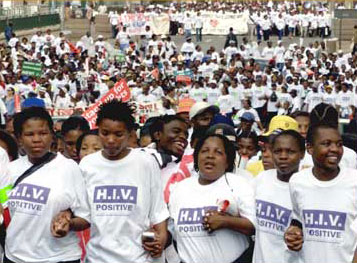 Growing public demands for access to AIDS treatment has helped speed up anti-retroviral therapy programmes.
Growing public demands for access to AIDS treatment has helped speed up anti-retroviral therapy programmes.Malawi and its development partners have responded to the desperate staffing shortage with a programme to improve salaries and working conditions for health professionals and to train a new cadre of health workers able to dispense ARVs and provide basic medical services.
Rebuilding Africa’s threadbare public health systems will take time, however, and for millions of people in the last stages of AIDS, time is running out. “Almost everyone would agree that the largest challenge resides around capacity,” says Dr. Mark Dybul, the assistant US global AIDS coordinator and chief medical officer for the PEPFAR programme. The US, the Global Fund and WHO programmes therefore focus on “supporting new people on therapy, but simultaneously building new capacity. I don’t think it’s correct to say that all [the recent increases] have been done using existing capacity.”
One small PEPFAR-supported clinic in Namibia, he notes, had the resources to treat several hundred people. “Now they have the capacity to treat a couple of thousand people. They’re taking people off the waiting list and putting them on the rolls, because they built new capacity at the same time they began treatment.”
Funding support, technical assistance and drugs and equipment could come from outside, Dr. Dybul told Africa Renewal. But for the programme to expand, there also needs to be capacity within the country. “And that’s got to begin with the national strategy commitment” of the governments and civil societies of affected countries. “What we do is support them.... We [all] need to do more, and we’re not there yet... but capacity has been expanded over the past year with tremendous success.”
The US programme alone added 155,000 people to the treatment rolls in just eight months in its 15 target countries: Botswana, Côte d’Ivoire, Ethiopia, Kenya, Mozambique, Namibia, Nigeria, Rwanda, Tanzania, Uganda, Zambia, Haiti, Guyana and Vietnam. Dr. Dybul says it is on track to reach the 500,000 mark by June 2006.
“I think there are a lot of misconceptions about [ARV] drugs,” Dr. Dybul adds. “The cost of anti-retroviral therapy is not drugs.... The major costs are supporting and training personnel, laboratory capacity and supporting those laboratories.”
Dr. Dybul puts the annual cost of ARV treatment in Africa at $1,500–$2,500 per person, with drugs accounting for just $300–$600 of the total. “Arguments about the cost of the drugs are for us a red herring,” he explains. “That’s not the problem right now.”
Patent, pricing controversies
But controversies over the safety, supply and cost of anti-AIDS drugs have continued. In contrast to Dr. Dybul’s assessment, WHO reported last December that “the high cost of ARV drugs remains a barrier to scaling up HIV treatment and care.” Prices for the next generation of anti-AIDS drugs, which will be needed as the virus develops resistance to current medications, “remain prohibitively expensive throughout much of the world,” the organization noted. It warned that action is needed now to control future costs.
For more than a decade after the development of the first anti-retrovirals in the late 1980s, their high cost and the complexity of using them kept the life-prolonging medications out of the hands of all but a few very wealthy or very fortunate people in poor countries. At $10,000–$15,000 per year, ARV treatment was simply unaffordable. Efforts by UNAIDS to negotiate discounted prices for developing countries enjoyed only limited success, and the major Northern pharmaceutical companies generally resisted calls to licence inexpensive generic versions of their patented products.
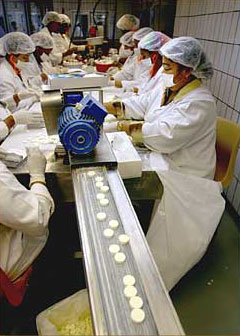 Making generic anti-AIDS medicines in South Africa. Will trade rules hamper generic producers?
Making generic anti-AIDS medicines in South Africa. Will trade rules hamper generic producers?In 2001, however, an Indian pharmaceutical firm, Cipla, introduced an innovative generic medication that combined three of the most effective anti-retroviral drugs into a single pill, known as the triple fixed dose combination tablet (FDC). Not only was the drug easier to administer than its patented competitors -- two pills a day compared with six or more of some of the patented formulations -- it was available initially for the unheard-of price of $350 per year. After a two-year investigation by WHO’s drug prequalification programme, the triple FDC was certified safe and medically equivalent to the patented originals, and went into wide use. With prices now as low as $140 a year, the triple FDC has emerged as the pharmaceutical backbone of the 3x5 campaign and is credited with making it possible to expand ARV treatment.
But PEPFAR requires its grantees to use only drugs certified by the US Food and Drug Administration (FDA), a policy that, in practice, has meant the programme buys only patented products, mainly from US suppliers. PEPFAR officials say the policy is necessary to ensure the safety and quality of drugs and note that a number of generic ARVs have been removed from the WHO pre-approval list after problems were discovered in the certification documents. They also note that foreign generics producers are welcome to submit their products for FDA approval under a special “fast track” procedure.
To date, however, none of the triple FDC drugs favoured in international treatment programmes has secured FDA approval. The result, reported the US government General Accounting Office, is that PEPFAR currently pays about twice as much for anti-retroviral medications as treatment schemes using generics. The agency estimates that the costs could potentially run into hundreds of millions of dollars over the five-year span of the PEPFAR initiative, reducing the number of people who can be treated for the same money.
In late January, the FDA approved its first generic ARV product, a two-pill package taken twice daily, and applications for other generic products, including triple FDCs, are under review. Treatment advocates welcome the development but charge that the failure of the US to adopt the preferred triple FDC tablet is forcing participating countries to manage different supply chains and treatment regimes -- complicating the drive to expand treatment.
Trade rules threaten affordability
The extension of 20-year patent protections to all but the least developed countries on 1 January 2005, under the World Trade Organization’s agreement on Trade-Related Aspects of Intellectual Property Rights (TRIPS), has also set off alarm bells among advocates and health officials. The agreement makes it more difficult for India and other major exporters of generic drugs to continue to supply developing countries with low-cost ARVs and other vital medicines.
The current generation of frontline anti-AIDS drugs are exempt from the new patent rules, says Mr. Brook Baker, a professor at Northeastern University in the US and a member of the treatment advocacy group Health Gap. “The problem will be with the next generation of ARVs in the pipeline. TRIPS will prevent the kind of generic competition that has driven prices down in the past.”
In August 2003, the WTO’s TRIPS Council, under pressure particularly from African countries to create a public-health exemption to the new rules, reached an agreement to permit the export of generic drugs for public health emergencies. But the exemption is limited and procedurally complex. To date, no country has attempted to use it.
Mr. Baker also notes that US negotiators are seeking patent protections in excess of WTO requirements in regional and bilateral trade talks. These so-called “TRIPS plus” agreements, Global AIDS Fund head Richard Feacham said last year, have the effect of “either pushing [drug] prices up or preventing their fall,” further limiting the availability of affordable medications.
Canada recently amended its patent laws to permit the pharmaceutical industry to use the WTO exemption, but according to Mr. Richard Elliot, the director of legal research and policy at the Canadian HIV/AIDS Legal Network and a member of the government’s Ministerial Council on AIDS, its provisions too are complex and restrictive. So far, he told Africa Renewal, no Canadian company has sought an export license under the new law.
Short on resources, long on needs
The rapid expansion of AIDS treatment programmes has brought with it equally dramatic demands for new resources. And while the 3x5 campaign and the US programme have short-term targets, they are creating long-term obligations to the millions of people entering treatment, since ARV therapy must continue for life. When UNAIDS was launched in 1996, the organization noted recently, global spending on the full range of HIV/AIDS initiatives in low- and moderate-income countries was $300 mn. Last year, reports the Washington-based Kaiser Family Foundation, spending topped $6 bn.
But even that impressive figure, notes the UN’s Mr. Lewis, is just half the $12 bn UNAIDS estimates is needed this year to continue expanding treatment programmes and meet education, prevention, counselling and research needs. The Global Fund needs $1 bn this year to cover its commitments, he says. “WHO is short $60 mn for the final vital push on 3x5 and they still don’t have it. I don’t understand this grudging incrementalism by Western countries. We’re losing incredible numbers of lives every day.”
UNAIDS estimates that by 2007 $20 bn will be needed for the fight against AIDS, and Mr. Lewis calls on wealthy governments to make major new commitments at the upcoming meeting of the Group of Eight industrialized countries. “We have more money now, but in a few years we’ll be fighting desperately for dollars again. Prices for the next generation of drugs are very, very high. They will have to be negotiated down and ways found to make generics.”
“Everywhere we turn we have impediments,” he acknowledges. “But we also have a momentum that is unstoppable. I see the focus everywhere in Africa. Now the commitment is tremendous.”










